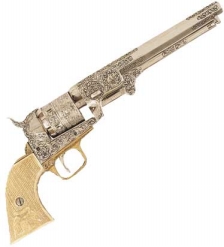

White then appealed to Congress, which drafted a Bill (S-273) “An act for the relief of Rollin White” that passed both houses but was retuned unsigned by President Ulysses S. Ironically, White’s application for a patent extension was summarily denied by the U.S. In 1868, White and S&W tried for a patent extension, just as Samuel Colt had done in 1850, successfully extending the strangle hold Colt had on the manufacturing of revolvers for another seven years. Aside from modification to the hammer, a change in cylinders, and scooping out the right recoil shield, the 1860 Army retains its original appearance. manufacturer of breech loading cartridge revolvers out of business for patent infringement or forced them to pay a royalty and stamp their guns as manufactured under license from Smith & Wesson, as well as bearing the Rollin White patent.Ī comparison between a Long Cylinder conversion and an 1860 Army percussion model reveals the minor, yet efficient changes made to convert the cap-and-ball guns to metallic cartridges.


Since 1857, S&W had litigated almost every U.S. found itself struggling with an inventory of cap-and-ball guns that were fast becoming obsolete, and unable to legally manufacture a cartridge loading revolver or conversion until the Smith & Wesson Rollin White Patent for the bored through cylinder expired in 1869. In 1865, the Colt’s Patent Fire-Arms Manufacturing Co. 32 rimfire caliber pocket pistols, (the latter a favorite backup gun for Union soldiers). armsmakers from manufacturing breech loading cartridge revolvers throughout the War Between the States, even though S&W was only manufacturing small. Grant had not been a fan of S&W, which through its patents had kept U.S. Many small manufacturers were driven to ruin, others caught up in patent infringement suits that had begun with Samuel Colt in the 1850s, and ended in 1869 with Smith & Wesson. Here, in the midst of Reconstruction, there was another revolution taking place, this one in the firearms world, as American armsmakers struggled with the postwar economy and a glut of wartime arms pouring into the open market. He endeavored to heal the rifts between North and South, while pressing for the completion of the Transcontinental Railroad at the beginning of the postwar Western Expansion, in the belief it would help unite the country. Grant, who was a military man with no political background, stepped into the Oval Office facing a still divided nation.


 0 kommentar(er)
0 kommentar(er)
